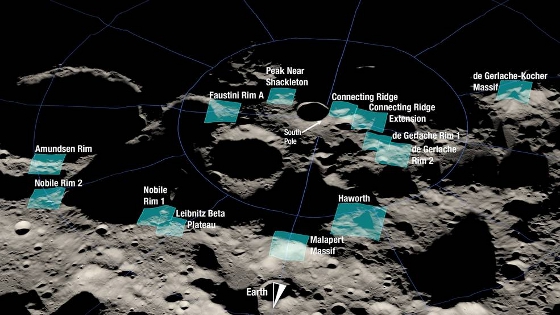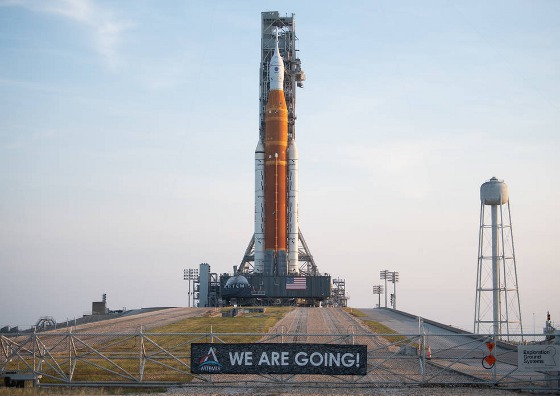 |
| August 23, 2022 | Volume 18 Issue 32 |
Designfax weekly eMagazine
Archives
Partners
Manufacturing Center
Product Spotlight
Modern Applications News
Metalworking Ideas For
Today's Job Shops
Tooling and Production
Strategies for large
metalworking plants
Americans return to the Moon: NASA eyes 13 candidate landing sites for new Artemis missions
By Vanessa Lloyd, Alana Johnson, and Kathryn Hambleton, NASA Headquarters
As NASA prepares to send astronauts back to the Moon under its Artemis mission, the agency has identified 13 candidate landing regions near the lunar South Pole. Each region contains multiple potential landing sites for Artemis III, which will be the first of the Artemis missions to bring crew to the lunar surface, including the first woman to set foot on the Moon.

Rendering of 13 candidate landing regions for Artemis III. Each region is approximately 9.3 by 9.3 miles (15 by 15 km). A landing site is a location within those regions with an approximate 328-ft (100-m) radius. [Credits: NASA]
"Selecting these regions means we are one giant leap closer to returning humans to the Moon for the first time since Apollo," said Mark Kirasich, deputy associate administrator for the Artemis Campaign Development Division at NASA Headquarters in Washington. "When we do, it will be unlike any mission that's come before as astronauts venture into dark areas previously unexplored by humans and lay the groundwork for future long-term stays."
NASA identified the following candidate regions for an Artemis III lunar landing (possibly as early as 2025):
- Faustini Rim A
- Peak Near Shackleton
- Connecting Ridge
- Connecting Ridge Extension
- de Gerlache Rim 1
- de Gerlache Rim 2
- de Gerlache-Kocher Massif
- Haworth
- Malapert Massif
- Leibnitz Beta Plateau
- Nobile Rim 1
- Nobile Rim 2
- Amundsen Rim
Each of these regions is located within six degrees of latitude of the lunar South Pole and, collectively, contain diverse geologic features. Together, the regions provide landing options for all potential Artemis III launch opportunities. Specific landing sites are tightly coupled to the timing of the launch window, so multiple regions ensure flexibility to launch throughout the year.
To select the regions, an agency-wide team of scientists and engineers assessed the area near the lunar South Pole using data from NASA's Lunar Reconnaissance Orbiter and decades of publications and lunar science findings. In addition to considering launch window availability, the team evaluated regions based on their ability to accommodate a safe landing, using criteria including terrain slope, ease of communications with Earth, and lighting conditions. To determine accessibility, the team also considered combined capabilities of the Space Launch System rocket, the Orion spacecraft, and the SpaceX-provided Starship human landing system.
VIDEO: NASA hasidentified of 13 candidate landing regions near the Moon's South Pole for the Artemis III mission, the first crewed mission to the Moon's surface since 1972. This video features a data visualization showing the locations of all 13 regions and highlights the interesting lunar topography and exploration potential of these areas. [Credits: NASA's Goddard Space Flight Center]
All regions considered are scientifically significant because of their proximity to the lunar South Pole, which is an area that contains permanently shadowed regions rich in resources and in terrain unexplored by humans.
"Several of the proposed sites within the regions are located among some of the oldest parts of the Moon, and together with the permanently shadowed regions, provide the opportunity to learn about the history of the Moon through previously unstudied lunar materials," said Sarah Noble, Artemis lunar science lead for NASA's Planetary Science Division.
The analysis team weighed other landing criteria with specific Artemis III science objectives, including the goal to land close enough to a permanently shadowed region to allow crew to conduct a moonwalk, while limiting disturbance when landing. This will allow crew to collect samples and conduct scientific analysis in an uncompromised area, yielding important information about the depth, distribution, and composition of water ice that was confirmed at the Moon's South Pole.
The team identified regions that can fulfill the moonwalk objective by ensuring proximity to permanently shadowed regions, and also factored in other lighting conditions. All 13 regions contain sites that provide continuous access to sunlight throughout a 6.5-day period -- the planned duration of the Artemis III surface mission. Access to sunlight is critical for a long-term stay at the Moon because it provides a power source and minimizes temperature variations.
"Developing a blueprint for exploring the solar system means learning how to use resources that are available to us while also preserving their scientific integrity," said Jacob Bleacher, chief exploration scientist for NASA. "Lunar water ice is valuable from a scientific perspective and also as a resource, because from it we can extract oxygen and hydrogen for life-support systems and fuel."
NASA will discuss the 13 regions with broader science and engineering communities through conferences and workshops to solicit input about the merits of each region. This feedback will inform site selections in the future, and NASA may identify additional regions for consideration. The agency will also continue to work with SpaceX to confirm Starship's landing capabilities and assess the options accordingly.
NASA will select sites within regions for Artemis III after it identifies the mission's target launch dates, which dictate transfer trajectories and surface environment conditions.
Through Artemis, NASA will land the first woman and the first person of color on the Moon, paving the way for a long-term, sustainable lunar presence and serving as a steppingstone for future astronaut missions to Mars. A launch date of no earlier than 2025 is the current schedule for Artemis III.
Learn all about Artemis at nasa.gov/artemis-1.
Editor's Note: NASA's Artemis I mission is scheduled to launch Aug. 29, 2022. Artemis I is an uncrewed flight test, the first in a series of increasingly complex missions to the Moon. This first flight will not land on the Moon.
During Artemis I, the uncrewed Orion spacecraft will launch on the most powerful rocket in the world and travel thousands of miles beyond the Moon, farther than any spacecraft built for humans has ever flown, over the course of about a three-week mission.

NASA's Space Launch System (SLS) rocket with the Orion spacecraft aboard is seen atop a mobile launcher at Launch Pad 39B, Aug. 17, 2022, after being rolled out to the launch pad at NASA's Kennedy Space Center in Florida. NASA's Artemis I mission is the first integrated test of the agency's deep space exploration systems: the Orion spacecraft, SLS rocket, and supporting ground systems. Launch of the uncrewed flight test is targeted for Aug. 29, 2022. [Credits: NASA]
Artemis I is targeted to launch during a two-hour window that opens at 8:33 a.m. EDT Monday, Aug. 29, from Launch Pad 39B at Kennedy.
Ten shoebox-size secondary payloads, called CubeSats, are hitching a ride to space on Artemis I's Space Launch System (SLS) rocket, and several other investigations are flying inside the Orion spacecraft during the flight test. Each of the payloads will perform science and technology experiments in deep space, expanding understanding of lunar science, technology developments, and deep space radiation.
Watch the launch on NASA's livestream at:
https://www.youtube.com/watch?v=6SkLFDypXH0
or
https://www.youtube.com/watch?v=CMLD0Lp0JBg
on Aug. 29. Full coverage on launch day begins at 6:30 a.m. EDT, with an 8:33 a.m. projected launch time.
Published August 2022
Rate this article
View our terms of use and privacy policy
